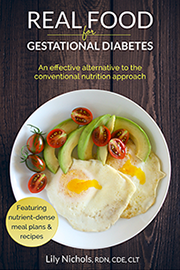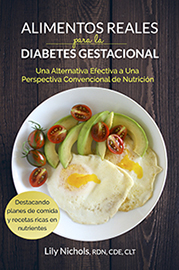
REAL FOOD FOR GESTATIONAL DIABETES IS AVAILABLE ON AMAZON IN BOTH PRINT & KINDLE
Foreign Language Translations of Real Food for Gestational Diabetes
GETTING DIAGNOSED WITH GESTATIONAL DIABETES IS SCARY.
But it doesn’t have to stay that way.
Imagine easily managing your blood sugar, effortlessly gaining the right amount of weight during your pregnancy, and giving birth to a beautiful, healthy baby.
This can be you.
YOU CAN HAVE GESTATIONAL DIABETES AND HAVE A HEALTHY BABY
With the wrong information (or no information at all), far too many women struggle with erratic blood sugar. This can lead to excessive weight gain, high doses of insulin or medication, and difficult births.
Sadly, this often happens despite following the dietary advice given by well-meaning clinicians; a restrictive diet that leaves them feeling unsatisfied, unhappy, and confused about their blood sugar levels.
In Real Food for Gestational Diabetes, registered dietitian and gestational diabetes expert, Lily Nichols, sets the record straight, offering revamped carbohydrate recommendations and exercise guidelines based on the latest clinical research.
With this book, you have the tools to turn this diagnosis into a blessing in disguise.
you’ll learn:
-
- Why conventional diet therapy often fails and what to do instead.
-
- How the right prenatal nutrition can reduce the likelihood you’ll need insulin by 50%.
-
- Exactly which foods raise your blood sugar (and more importantly, which foods DON’T raise your blood sugar)
-
- How to customize a meal plan with the right amount of carbohydrates for YOU (there’s no one-size-fits-all plan, despite what you may have been told)
-
- The truth about ketosis during pregnancy (and why checking urine ketones isn’t useful)
-
- Information on insulin and blood sugar-lowering medications used in pregnancy
-
- Which foods to emphasize to provide your baby with the right nutrients for optimal development (these real foods have a long history of producing strong, healthy babies)
-
- The best prenatal exercises to control your blood sugar and prepare for labor
-
- What to do after delivery to prevent type 2 diabetes
This book is the missing prenatal nutrition education that you’ve been searching for.
Pregnancy is full of unknowns, but one thing to remember is that good nutrition “stacks the deck” in your favor. Whatever the outcome, you know you did everything within your control to have a healthy pregnancy.
Eating a nutrient-dense diet of real food sets you up for a healthier pregnancy, a smoother recovery from birth, and an easier transition into motherhood. Let me show you how.
REAL FOOD FOR GESTATIONAL DIABETES IS AVAILABLE ON AMAZON IN BOTH PRINT & KINDLE
Foreign Language Translations of Real Food for Gestational Diabetes
Please direct foreign language rights inquiries here.
what moms are saying
I had gestational diabetes with my last pregnancy and followed the dietician’s recommendations very closely… I ended up on insulin a few weeks before I was due, which transferred my care to an OB and I wasn’t able to have the home birth that I wanted.
So for this pregnancy, my husband and I prayed much that God would help us with the diabetes. I found your book, then your website, and then bought the course. Thanks to your real food approach, I was able to manage my glucose on my own through diet and lifestyle (no insulin this time) … I had a glucometer and the strips and tested myself regularly (the glucometer was my accountability partner;-)).
I’m so pleased to share we had a normal vaginal delivery at home with the midwives aid… it was such a more relaxed pregnancy and birth experience! Also, I found gestational diabetes to be a blessing in disguise. I now have a lot more practice and knowledge about how to take care of my health even outside of pregnancy and I’ve dropped some bad habit foods that I had before pregnancy, the biggest being sugar.
Also I want to mention that I donated your book to our local midwives office and they are going to try to make more books available for others!
With our 3rd baby, I ate a whole foods diet because that’s just how I cook, but I did follow the carb counts that my dietician recommended. With that pregnancy, my sugars were just fine too. With this pregnancy, I was eating much lower carbs throughout the whole pregnancy not just at the end after I failed my test. I stumbled across your book as I was preparing my question list for my first appointment with the dietician. I read it as fast as I could and found that most of what you recommend in your book, I was already doing. I was relieved and I felt I had some ground to keep doing what I was doing.
I ended up seeing the same dietician as I did with my 3rd child. She gave me the same advice as before. In fact, she told me to eat more carbs and gave me the green light on adding in bread and a little bit of added sugar. She looked at my food log and said I was eating far too few carbs and warned me about ketosis. I went to my appointment with questions about how a paleo diet worked with GD, how I could possible have GD with an A1c of 4.6 (I had it tested three times during pregnancy. 5.1 at 10 weeks, 4.8 at 20 weeks and 4.6 at the same time as my glucose tolerance test around 28 weeks), was it possible to fail the tests because I just wasn’t used to eating lots and lots of carbs, were there natural remedies that I could try, how could a person to eats clean and is pretty active have GD etc. She had no answers. She just told me to get my 175 grams a day and keep eating my whole foods diet.
I was highly dissatisfied that she didn’t have any answers to my questions. I tried to eat 175 grams of carbs. It was so hard. I found myself feeling like I was force feeding myself. Not to mention, it was affecting my blood sugars. I was reaching the 120 mark most of the time, but I had been accustomed to a 100 reading at the 1 hour mark and the low 80s at the 2 hour mark…and I liked being under the target. I could see that if I continued to follow her advice, I’d be in the “failed diet therapy” category, so I went back to my paleo-ish ways.
Week after week, our baby was growing steadily in the 50th percentile and wasn’t showing any signs of being effected by my blood sugar. Our 4th baby was 7 lbs 14 oz and his blood sugars were perfect each time they tested him after his birth. (Our 3rd baby, who I followed the 175 grams rule with was just over 9 lbs.) He was proof to me that how I was eating had served us well and protected us from the risks involved with uncontrolled diabetes and the risks associated with diabetes medicines. I want to thank you for empowering me to follow my gut, to trust whole foods, and to be a little bit of a rule breaker and step away from conventional diabetes advice!
We have a beautiful baby boy and an empowered momma! Thank you for your work and for getting the word out there that whole foods are best for babies!”
After he was born, I slipped back into bad habits, but I’ve recently returned to a low carb diet. I’ve lost 28 pounds since the beginning of June by following this plan.
Thank you for the work you do, and for making it accessible to people like me. I don’t think I’d be here without you!
I want to personally thank you for your book “Real Food for Gestational Diabetes.” The knowledge and insight you shared in this book truly made a difference in my final 2 months of pregnancy.
I have always attempted to and enjoyed eating a healthy diet since I was a teen. I chose to be a vegetarian at the age of 18 and although I now will eat fish, I have remained so the last 20 years. I am also a ballet teacher by profession, and continued to teach all the way through my most recent pregnancy. I was baffled when in my seventh month, my glucose tests came back with levels that the doctor diagnosed as gestational diabetes. I was referred to a GD dietician who could not see me for another two weeks. I was heart-broken, angry, and I had many unanswered questions. Thankfully my midwife from my first pregnancy recommended your book. I ordered it the very day I was diagnosed, read it in one sitting, and started closely following your dietary recommendations. I found the changes were manageable and you encouraged me to start incorporating more sources of protein in my daily intake. I also started checking my glucose levels three times a day and documenting them until I was able see the GD in person. When I went in for my first dietary consultation, they were pleasantly bewildered. She could not believe my levels were all within range (with room to spare) and told me that whatever I was doing, to keep doing it. I shared your book with her, and from that day until I delivered, I never had a glucose level that was off.
Our baby girl decided to arrive 4 weeks early (October 25, 2020) and by God’s Grace she came out healthy, weighed 5 lb 15 oz, and had no complications. She also passed her glucose tests and was not admitted to the NICU. We are so grateful to God, and we are sincerely grateful to you for your expertise and encouragement through my final months of pregnancy. I believe if it had not been for your counsel, I would have been lost as to where I needed to make necessary adjustments. I am continuing to follow your advice post-partum as I feel both healthier and nutritionally empowered by your keto approach. Thank you and may the Lord continue to bless the work that you do.
Read 250+ customer reviews on Amazon
Endorsements from experts
A year ago, I found out via Jan Vyjidak about the results of low carbohydrate high fat (LCHF) diets in diabetes and about the experience of Lily Nicholls with low carbohydrate diets in the treatment of GDM. It turned out that my beliefs about harmful effects of ketone bodies during pregnancy, which I simply adopted as an undisputed fact, was plucked out of thin air.
A year has passed, and thanks to the diet recommended by Lily, I have found out that patients with GDM mostly do not require bolus insulin. An educational website for women with GDM, which I developed myself, has been amended, and thanks to the kind support of my colleagues, we have jointly corrected also our official dietary guidelines for the treatment of GDM in the Czech Republic.
As a result, the new dietary recommendations for GDM only refer to a maximum limit of 200 grams of carbohydrates per day, there is no minimum recommended intake and in individual cases, the diet can easily be a low carbohydrate diet. Patients who have already been on similar diets before conception are advised to stay course during pregnancy, as long as the diet suits them well. I do not automatically recommend women to adopt LCHF during pregnancy per se, but it is possible to gradually adopt a carbohydrate restricted diet and avoid the need for bolus insulin. We do, however, keep a stricter carbohydrate restriction as an option in cases where postprandial self-monitoring of blood glucose suggests it is necessary.
I would like to thank Lily for broadening my horizons and for improving outcomes of Czech women with GDM.
I just wanted you to know we LOVED your book! We made several recipes in the Food Science Lab and they were all a hit. We especially appreciate your knowledge from both the clinical and research experience you have. Please keep encouraging and educating dietitians and students as you have with your book, blog, and practice!
By the way – I also shared your title with my former coworkers at the WIC clinic. As I read, I keep thinking to myself, “I wish we could give a copy to every WIC client!” I think so many women could benefit from your knowledge and experience.”
It’s been a year or more, but we’ve now officially reduced the carb recommendations in all teaching materials, menus, and handouts to 15g for breakfast and optional snacks and <45g at lunch and dinner for our GDM patients. Better yet, I no longer get strange looks when I don’t force my pregnant patients to eat carbs if they don’t want to. Our medical director is also becoming receptive to new information, and I look forward to your next book to update any other curriculum as needed! It helps me make my low carb case when the words are coming from another dietitian that isn’t afraid to back it up with some evidence!
I could tell from your website and videos that you and I are on the same page. ???? I told her that your information is great and she should follow your book. Between her initial diagnosis and her appointment with the hospital dietitian (just a few days), she took the information from you (and me), immediately implemented it, and had her blood glucose back in the appropriate range.
When she returned from the hospital RD, she said that the RD told her that she was not eating enough carbs. She laughed because both you and I had told her that’s the information she would be given. Just to check, she increased her carb for 1 meal, and, of course, her blood glucose increased out of range. She was surprised that such incorrect information is still being taught. I want to thank you for validating my information to her. It was not just from her “mother-in-law”.
Happily, she is enjoying meals with lots of veggies, quality protein, and healthy fat; even posting photos of them on Facebook. She is doing very well with her blood glucose and weight; her baby girl is due in mid October (my first granddaughter). Keep up the great work!”
UPDATE: I just wanted to give you the final update on my new granddaughter. Thanks to you, me, and my daughter-in-law’s compliance, her baby was perfect. 7lb 8 oz born naturally after (only) 12 hours of labor. She is nursing and the baby is growing beautifully. Your book will be donated to their midwife group, so the information will be passed on. Thanks again!
Take control of your gestational diabetes, naturally!
Learn how in this free 3-part video training.


